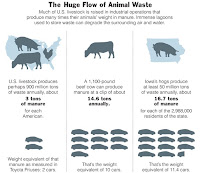
I can't improve upon this article, and am extremely impressed that it appeared in the New York Times. Well done dudes.
Here are some of the passages that made me raise my fist and say "Right f#$&*'ing On!" But, hell, this article is so good... don't read what I've excerpted, just read the article!!! : )
Global demand for meat has multiplied in recent years, encouraged by growing affluence and nourished by the proliferation of huge, confined animal feeding operations. These assembly-line meat factories consume enormous amounts of energy, pollute water supplies, generate significant greenhouse gases and require ever-increasing amounts of corn, soy and other grains, a dependency that has led to the destruction of vast swaths of the world’s tropical rain forests.
Growing meat (it’s hard to use the word “raising” when applied to animals in factory farms) uses so many resources that it’s a challenge to enumerate them all. But consider: an estimated 30 percent of the earth’s ice-free land is directly or indirectly involved in livestock production, according to the United Nation’s Food and Agriculture Organization, which also estimates that livestock production generates nearly a fifth of the world’s greenhouse gases — more than transportation.
To put the energy-using demand of meat production into easy-to-understand terms, Gidon Eshel, a geophysicist at the Bard Center, and Pamela A. Martin, an assistant professor of geophysics at the University of Chicago, calculated that if Americans were to reduce meat consumption by just 20 percent it would be as if we all switched from a standard sedan — a Camry, say — to the ultra-efficient Prius.
Though some 800 million people on the planet now suffer from hunger or malnutrition, the majority of corn and soy grown in the world feeds cattle, pigs and chickens. This despite the inherent inefficiencies: about two to five times more grain is required to produce the same amount of calories through livestock as through direct grain consumption, according to Rosamond Naylor, an associate professor of economics at Stanford University. It is as much as 10 times more in the case of grain-fed beef in the United States.
The environmental impact of growing so much grain for animal feed is profound. Agriculture in the United States — much of which now serves the demand for meat — contributes to nearly three-quarters of all water-quality problems in the nation’s rivers and streams, according to the Environmental Protection Agency.
Because the stomachs of cattle are meant to digest grass, not grain, cattle raised industrially thrive only in the sense that they gain weight quickly. This diet made it possible to remove cattle from their natural environment and encourage the efficiency of mass confinement and slaughter. But it causes enough health problems that administration of antibiotics is routine, so much so that it can result in antibiotic-resistant bacteria that threaten the usefulness of medicines that treat people.
Those grain-fed animals, in turn, are contributing to health problems among the world’s wealthier citizens — heart disease, some types of cancer, diabetes. The argument that meat provides useful protein makes sense, if the quantities are small. But the “you gotta eat meat” claim collapses at American levels. Even if the amount of meat we eat weren’t harmful, it’s way more than enough.
Americans are downing close to 200 pounds of meat, poultry and fish per capita per year (dairy and eggs are separate, and hardly insignificant), an increase of 50 pounds per person from 50 years ago. We each consume something like 110 grams of protein a day, about twice the federal government’s recommended allowance; of that, about 75 grams come from animal protein. (The recommended level is itself considered by many dietary experts to be higher than it needs to be.) It’s likely that most of us would do just fine on around 30 grams of protein a day, virtually all of it from plant sources.



